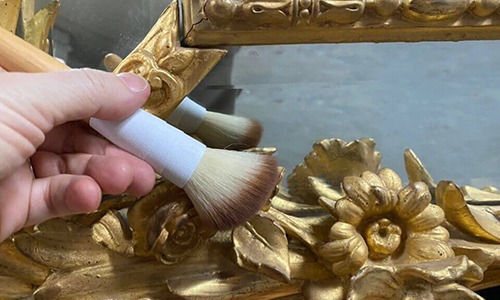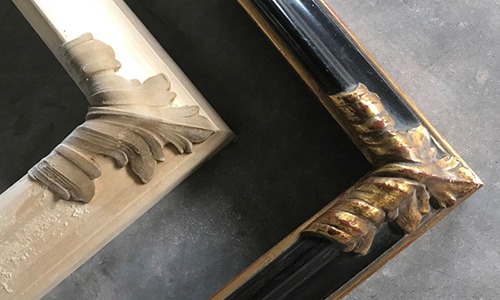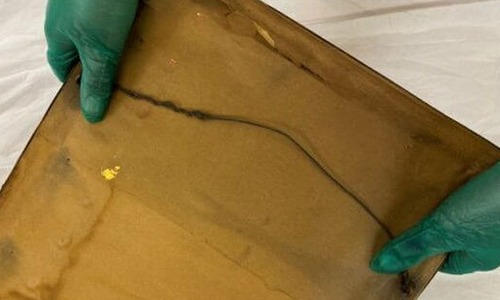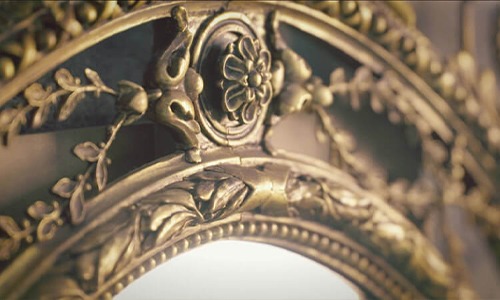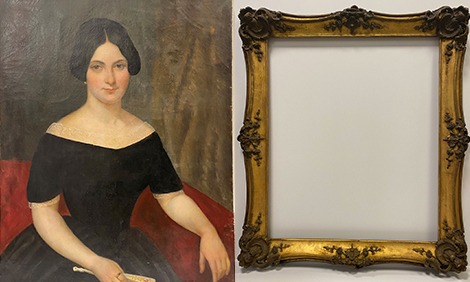Collection Care
Handling
Fine Art
By April Hann Lanford
Handling Fine Art
By April Hann Lanford
Improper handling poses one of the greatest risks to the damage of an item.
Whenever handling a work of art, it is important to identify if there are areas of damage or weakness. Keeping an eye for areas of instability and understanding the construction of a piece can all play an important role in how the work is handled, packed, and/or transported.
Frames
Ornate Frames
Pay close attention to frame ornamentation on ornate frames, since they protrude from the frame profile, they are often vulnerable to damage and tend to be in an unstable condition. On ornamental frames, while it sounds straightforward, ornamentation that extends from the lower edge of the bottom rail is often damaged from handling by simply sitting the frame on the floor, and the ornament is immediately impacted from direct contact with the floor. When handling ornamental frames, avoid putting stress on any of the ornamentations. Handle the frames on the bottom and the sizes. The lower rail should always be supported. Rather than placing the piece in direct contact with the floor, framed works should be placed on top of foam blocks.
Care for the Corners
Corners on frames are also vulnerable to damage. Corners can be dented, and the miters are compromised by impact. Review for open joins, or related cracks in the corners. When handling, the lower rail should always be supported.
Gold Leaf and Painted Finishes
Review gilded and painted finishes for areas of loss, flaking, cracks, etc. Often areas of loss denote that the adjacent areas are also weak and could be further compromised. Avoid touching these weak areas. If detached elements are found, place them in a labeled envelope or bag, and keep them with the piece. Never put tape on the surface of a gilded or painted frame. Even a small piece of scotch tape can cause irreversible damage to a stable gilded surface.
Check the Back
Review the hanging hardware on the back of a frame. Check to make sure it is secure.
Never handle a frame by its wire or other hanging hardware. The stress from handling can cause the wire to break, or the hardware to pull out of the frame. Confirm how the framing materials are secured within the frame. Are they securely installed, or are the materials loosely put in with a few nails, thus endangered to fall out? If you are handling a compromised frame, always make sure that the components are stably secured inside. Whether by adding additional hardware or through careful handling.
Works on Paper
Review the glazing on the piece. Is it framed with glass that is prone to breaking, or framed with acrylic that is shatter resistant? What is the surface of the glazing? Is that surface sensitive to handling/contact?
Glass film can be used on most glass to deter breakage. It is best to avoid shipping items glazed with glass and use acrylic instead. When packing items glazed with anti-reflective glazings, it is best to not apply anything to the surface as it could irreversibly mar the sputtered coating.
Orientation
Review the orientation of the piece, and how it is mounted within the frame. Is the piece stable in the frame? When handling work on paper, if it is securely mounted, it is best to handle it in its proper orientation. If you pack and handle a framed work on paper upside down, it could cause stress on the hinges and cause further damage.
Check to see if an item is loose or has slipped from its mount. If it is loose, it will likely appear crooked, have fallen to the lower edge of the frame, or the image is misaligned within the mat window. Loose items should be carefully secured, unframed, or transported flat.
If the photograph or work on paper is warped, review the piece closely to determine if any of the media is in contact with the glazing. Mishandling can cause the adhered media to detach from the rest of the sheet. Never try to detach the work yourself, this type of condition is usually best resolved by a conservator to achieve the best possible outcome.
Paintings
Unframed Canvases
Always check for deformations, bulges, losses, cracks, and instability in the paint layer. Avoid touching the surface of the paint layer.
When handling, always handle by the sides and the lower edge of the stretcher. Never simply hold from the upper rail or wrap fingers around the interior of the stretcher so that they touch the interior of the canvas. Rather than placing a canvas in direct contact with the floor, unframed canvases should be placed on top of foam blocks.
Rather than placing a canvas in direct contact with the floor, unframed canvases should be placed on top of foam blocks.
Check the back of a painting for a rigid backing board. Often, part of the standard of care is to install a backing board to protect the back of a canvas after it has been treated. If the canvas does not have a backing board, avoid contact with the back of the canvas.
If you see a backing paper, don’t get caught with a false sense of security, double-check to make sure that there is a rigid backing behind the paper dust cover.
Never lean anything against the back (or front) of a canvas.
These are a few key best practices to keep in mind when handling fine art. If you have had an item or collection that has been compromised from fire, moisture, impact, or elevated levels of humidity, a specialist should be contacted immediately as it adds further complexity to how the artwork should be handled.
If you have any questions about handling or care of your collection, please contact us at:
312-344-0331
April@artifactservices.com
Our collection of educational articles about
custom framing, collection care, and emergency response are updated regularly.
Click on each topic below for a menu of corresponding articles.
Collection Care Articles
By April Hann Lanford
Our collection of educational articles provides an introduction to many topics about the preservation and conservation of fine art, antiques, and fine furniture.
Topics are often written as a result of questions provided by our clients.
Emergency Care Articles
By April Hann Lanford
Our emergency care articles are a helpful introduction to how to prevent damage through preventative measures or art and antique collections. When a disaster strikes, prompt response and taking the right steps can mitigate further damage.
Antique Trader Articles
By April Hann Lanford
Visit our collection of articles that have been published in Antique Trader.
antiquetrader
For more than 60 years Antique Trader has been inspiring, informing, and entertaining the collecting community with timely...
Projects
By April Hann Lanford
A selection of Artifact’s most recent projects highlighting our conservation and preservation work. We present each unique story describing the conservation process from reviewing the history, cause of loss, and condition to the steps of the treatment.
Glossary
A collection of art and conservation terms along with makers and firms compiled into a glossary and highlighted throughout our website for reference.
We are available to assist you
Main Location
840 N. Milwaukee Ave, Chicago IL 60642
Mon-Fri: 9:00 am - 5:30 pm
Sat: 10:00 am-4:00 pm
Sun: Closed
Complimentary parking is available in the loading zone in front of the building
We can also serve you by appointment at our other locations in the Chicagoland area.
Additional Locations
Schiller Park • Highland Park • Lake Forest • Lincoln Park • Nashville, TN
Copyright 2024, Artifact Services, LLC | An Artmill Group Company
